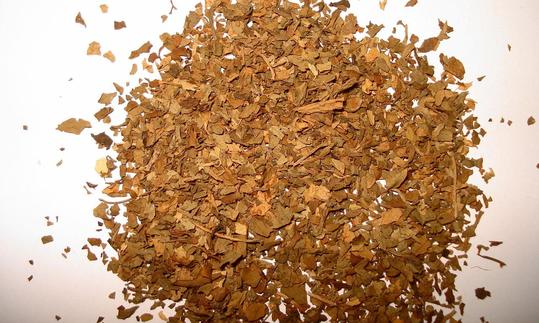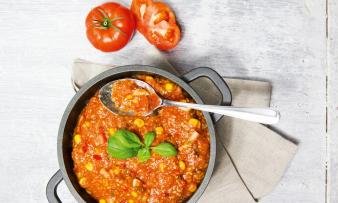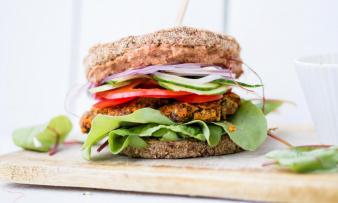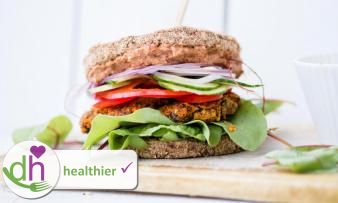Table of contents
Dried parsley ( Petroselinum crispum) is a popular herb and can be combined with many dishes. After conventional drying, it is often no longer raw, but you can buy it in organic quality.
Use in the kitchen
Parsley is cultivated as cut parsley and root parsley ( Petroselinum crispum var. tuberosum). There are two varieties of cut parsley that can be distinguished visually: curly parsley ( Petroselinum crispum var. crispum) with curly leaves and flat-leaf parsley ( Petroselinum crispum var. neapolitanum) with smooth leaves. 1 Flat-leaf parsley varieties have a stronger flavor than curly-leaf varieties. 2
This article focuses on the use of the dried herb (curly-leaf and flat-leaf parsley). You can find out more about fresh parsley in the related article.
Dried parsley can be used to season or garnish sauces, soups, or all kinds of hearty dishes - but fresh parsley is better as a garnish. It also goes wonderfully with potatoes, mushrooms, and vegetables such as carrots, red bell peppers, aubergines, and green beans. With its spicy flavor, this kitchen spice also livens up salad dressings, pestos (e.g. with green mint or walnuts) and dips for raw vegetable sticks. In addition, parsley, along with tomatoes,pepper, cream (vegan alternative: oat cream) and Parmesan (also available in vegan version), is a central ingredient in the Italian dish Pasta alle cinque Pi (pasta with five Ps). If you soak dried parsley in cold water for a few minutes, the aroma can develop better afterwards.
You can replace dried parsley with fresh parsley. However, since dried herbs have a more intense flavor, you should adjust the amount of fresh herbs accordingly. The rule of thumb for most herbs is: 1 teaspoon of dried herb equals 1 tablespoon of fresh herb.
Depending on the drying and processing method, dried herbs can be of raw food quality. The maximum temperature during drying should not exceed 42 °C. If nothing is stated for conventionally dried herbs, it is likely that they are not raw products. If you grow parsley, you can dry the herb yourself after harvesting, making sure it is of raw food quality.
Homemade preparation
Fresh parsley is easy to dry yourself - in the air, in the oven or in a dehydrator.
In the air: Tie shoots together in small bunches and hang them upside down in a ventilated, dry, warm place without direct sunlight and with temperatures between 20 and 30 °C. 3
In the oven or dehydrator: spread the plant parts on a baking tray lined with baking paper and put them in the oven at a maximum of 40 °C (raw food quality). The oven door should be opened a crack, e.g. by using a wooden spoon wedged in. If you have a dehydrator, you can spread the shoots on its rack and also dry them at a maximum of 40 °C. 3
The end of the drying process can be recognized by the rustling of the leaves and the slight breaking of the stems. In the air, this should be the case after one or two days, and after a few hours if dried in an oven or dehydrator. Before filling dried parsley into screw-top jars, you should allow it to cool down well. If kept in a dark, airtight container, the dried herb will keep for a long time. 3
Vegan recipe for herb curd with dried parsley
Ingredients (for 1 large bowl): 95 g macadamia nuts (alternatively: cashew nuts), 3 tbsp soy yoghurt, 175 ml vegetable stock, 2 tsp apple cider vinegar, 2 tsp lemon juice, 1-2 tsp onion powder, 1 tsp garlic powder, 1 tsp dried parsley (preferably raw and organic), 1 tsp dried chives (or 1 tbsp fresh chives), ½ tsp celery seeds, ½ tsp dried dill.
Preparation: Put all ingredients except soy yoghurt and dried herbs in a high-performance blender and mix until a creamy consistency is achieved. Add herbs and mix again until fine. Empty the mixture into a bowl and fold in the soy yoghurt. It is best to put vegan herb curd in the fridge for a few hours before use. Tastes wonderful as a dip for all kinds of vegetables, as a salad dressing or sandwich sauce, but also with potatoes. It can be stored airtight and will last for a week.
Vegan recipes with parsley (dried) can be found under the note: " Recipes that have the most of this ingredient ".
| Not only vegans or vegetarians should read this: Vegans often eat unhealthily. Avoidable nutritional errors. |
Purchasing - Storage
In most supermarkets (e.g. Coop, Migros, Denner, Volg, Spar, Aldi, Lidl, Rewe, Edeka, Hofer, Billa) you can buy dried parsley all year round. Organic supermarkets (e.g. Denn's Biomarkt, Alnatura) also offer dried parsley in organic quality. The dried herb is mainly found shredded in spice jars or small bags.
The availability of parsley (dried) varies depending on the size of the store, catchment area, etc. You can find our recorded food prices for the DA-CH countries above under the ingredient image - and by clicking you can see their development at various suppliers.
Storage tips
Dried parsley will last for several years if stored in a dry, airtight container, protected from light.
Ingredients - Nutritional values - Calories
Here we realistically show you the ingredients of spices and herbs per 1 g (instead of per 100 g as usual).
What is the nutritional value of parsley (dried)? 1 g of parsley (dried) has a calorie content of 2.92 kcal. The carbohydrate content is 0.51 g/1g and thefiber content 0.27 g/1g. The dried plant contains relatively high levels of protein (0.27 g/1g) and hardly any fat (0.06 g/1g). 4
Does dried parsley contain vitamin K? Dried parsley contains a lot of vitamin K at 13.6 µg/1g, and dried coriander leaves contain a similar amount (13.6 µg/1g). An even higher content can be found in other dried herbs such as thyme (17.14 µg/1g), basil (17.14 µg/1g) and wild garlic (26.25 µg/1g). 4
In addition to vitamin K, manganese and riboflavin (vitamin B2) are the most important essential nutrients that dried parsley offers. However, because the amount consumed is so small, they and the macronutrients do not contribute significantly to meeting the daily requirement. Far more important for the health value are the secondary plant substances in this ingredient, which can have an effect even in trace amounts. Although all herbs and spices have many health-promoting ingredients, we deliberately avoid the insubstantial buzzword "superfood" here.
Does dried parsley contain any vitamins? In addition to the high levels of vitamin K and riboflavin, dried parsley is also rich in vitamin C (ascorbic acid), folate and vitamin E (alpha-tocopherol). Does dried parsley contain iron? Iron is also present in abundance in the dried herb.
The complete ingredients of parsley (dried), the coverage of the daily requirement and comparison values with other ingredients can be found in our nutrient tables. In the article Nutrients explained you will get a detailed insight into the topic.
Health effects
Is dried parsley healthy? A range of bioactive substances, including essential oils (myristicin, apiol), flavonoids (apigenin, apiin, 6"-acetylapiin), coumarins, furocoumarins (bergapten, imperatori), carotenoids, ascorbic acid, various terpene compounds, phthalides and tocopherol, are contained in parsley ( Petroselinum crispum), both in the herb, roots and fruits. 1,5,6,7 The contents of the substances are greatest in the fruits (seeds). 7
Due to these compounds, parsley has pharmacological activities such as antioxidant, antidiabetic, antihypertensive, anticoagulant and diuretic effects. It also protects the liver, stomach, brain, nerve cells and cells and has antibacterial and antifungal activities. Analgesic (pain-relieving), spasmolytic (antispasmodic) and estrogenic properties of parsley are also known. 1,5,6
Dangers - Intolerances - Side effects
Large amounts of myristicin and apiol (components of parsley essential oil) can have a uterotonic (uterine contracting) effect. Taking more than 10 drops of the oil per day can cause abortion. It is therefore not recommended for use during pregnancy. 2,7,8
Results from a 2013 study also indicated that ethanol extracts from parsley leaves were mildly hepatotoxic (toxic to the liver) and nephrotoxic (toxic to the kidneys) at sustained oral doses of 1000 mg/kg or more. However, no toxicity was observed at lower doses. The use of parsley extracts should be avoided in patients taking lithium, which is common in psychiatric patients, in those taking vitamin K antagonists as anticoagulants (blood clotting inhibitors), and in those undergoing opioid therapy. 8
Folk medicine - naturopathy
In traditional and folk medicine, parsley is used as an anti-inflammatory agent, for the treatment of gastrointestinal diseases, high blood pressure, heart disease, urinary tract diseases, diabetes, middle ear infections, colds and various skin diseases. 1,5,7
In ancient Greece and Rome, parsley was used as a diuretic, digestive and menstruation-stimulating agent. Even today, parsley is used to treat amenorrhea (absence of menstruation) and dysmenorrhea (menstrual cramps). 5,9 Another area of application in folk medicine is as a means of stimulating milk flow in women who have recently given birth. Applied externally, parsley is said to provide relief from insect bites. 7
Ecological footprint - animal welfare
Parsley is generally an ingredient with an excellent ecological balance. Even if you put the CO 2 footprint in relation to the daily requirement; i.e. look at protein, fat, calorie content, etc. Fresh parsley has a CO 2 footprint of 0.24 kg CO 2 eq/kg. 15 The Danish climate database Concito also shows similar values for fresh basil with 0.33 kg CO 2 eq/kg. When dried, the values for basil are much higher at 7.34 kg CO 2 eq/kg. 18 Unfortunately, we do not know any specific values for dried parsley; CarbonCloud shows a general value of 4.12 kg CO 2 eq/kg. Depending on the drying method, environmental pollution can also be added and increase the ecological balance many times over. 17
The carbon footprint of a food product depends on various factors. The type of agricultural production (conventional vs. organic), average or seasonal or regional production, domestic production or import by truck, ship or plane, different types of packaging and whether the product is fresh or frozen all play a decisive role.
As a rule of thumb, you should avoid importing food by plane and often the ecological balance of imported food is better than the same product produced in a domestic greenhouse. 15
If you only use small amounts of herbs occasionally, it is best to use dried herbs - these have a long shelf life and therefore lead to less waste. It is more environmentally friendly to buy large refill packs instead of buying a new spice jar or tin every time. 10 Also look for organic products that have not been transported too far.
In general, studies on the ecological footprint of herbs are rare. This also applies to the water footprint. However, one study was devoted to this neglected topic. It examined various Mediterranean herbs for their environmental impact. Although parsley was not one of these herbs, this analysis can still be used to get a rough idea. The water footprint of the farms examined was between 13 and 277 l/kg, conventional mint had the smallest footprint and organic rose the highest, with oregano and rosemary in between. 16
For detailed explanations of various sustainability indicators (such as ecological footprint, CO2 footprint, water footprint), see our article: What does the ecological footprint mean?
Worldwide distribution - cultivation
Parsley is thought to have originated in the western Mediterranean and is now grown naturally in most Mediterranean countries and many temperate countries. The herb is cultivated in most Mediterranean countries, Europe, Russia and North America. Parsley is cultivated on a small scale in the tropics, including Southeast Asia. 1,9,11
Outside the Mediterranean region, parsley plants can occasionally be found growing wild on rubble heaps - these are probably garden escapees. 7,12
Industrial production
Due to the high water content of fresh parsley, the herb is usually dried for the market to inhibit the growth of microorganisms and prevent degradation through biochemical reactions. Drying also leads to a significant reduction in weight and volume and minimizes packaging, storage and transport costs. 13
A 2002 study investigated the influence of different drying methods (oven drying at 45 °C, air drying at room temperature and freeze drying) on volatiles in parsley leaves. Drying at room temperature was the drying method that caused the least change in composition. Oven drying at 45 °C and freeze drying resulted in a decrease in most volatile compounds, especially compounds that contribute most to the characteristic parsley odor (eg p-mentha-1,3,8-triene and apiol). 14
Is freeze-dried parsley healthy? Parsley dried at room temperature still contains the most bioactive substances. But despite the decrease in these substances, the content in freeze-dried or oven-dried parsley is not zero.
Further information
Parsley ( Petroselinum crispum ; syn. Petroselinum sativum) is a plant species in the carrot family (Apiaceae). It is related to herbs such as dill, chervil and caraway.
In ancient times, parsley was the subject of a variety of customs. The ancient Greeks used parsley to decorate funeral wreaths and parsley garlands to honor the winners of the Nenena and Isthmain sports games. In ancient Rome, parsley was used in funeral ceremonies because the herb was associated with Persephone, goddess of the underworld. They also used parsley to deodorize corpses and to mask alcohol breath. In the Hebrew Passover celebrations, parsley was considered a symbol of spring and rebirth. Later, in Christianity, parsley was associated with the apostle Peter (guardian of the gates of heaven). 1:9
Alternative names
Parsley has many alternative names: Petersil, Peterli, Peterle, Peterling, Petergrün, Silk, Bittersilche, Goat's weed, root parsley, Beterli, Federsielli, Felswurz, Gartenäppich, curly or plain herb parsley, Kräutel, curly parsley, Paiterling, Pautersillle, Pedarsilli, Peiterzilk, Perlin, Peterchen, Peterlein, Petercelie, Petercile, Peterlin, Petersilge, Petersilgen, Parsile, curly parsley, parsley root, Petersiligen, Parsille, Petersillige, Petirsil, Petrosil and Pitterseltch.
In English, parsley is called parsley or garden parsley, and dried parsley is called dried parsley.
Drug name: Parsley fruit = Petroselini Fructus (formerly Fructus Petroselini), parsley root = Petrosini Radix. 11
Bibliography - 18 Sources
| 1. | Agyare C, Appiah T, Boakye YD, Apenteng JA. Petroselinum crispum: a Review. Medicinal Spices and Vegetables from Africa. 2017: 527-547. |
| 2. | Bown D. The Royal Horticultural Society. Encyclopedia of Herbs & their Uses. Dorling Kindersley: London; 1995: 325. |
| 3. | Mein-schoener-garten de: Petersilie trocknen: Praktische Tipps. 2020. |
| 4. | USDA United States Department of Agriculture. |
| 5. | Farzaei MH, Abbasabadi Z, Ardekani MRS, Rahimi R, Farzaei F. Parsley: a review of ethnopharmacology, phytochemistry and biological activities. J Tradit Chin Med. 2013;33(6):815-826. |
| 6. | Mahmood S, Hussain S, Malik F. Critique of medicinal conspicuousness of Parsley (Petroselinum crispum): a culinary herb of Mediterranean region. Pak J Pharm Sci. 2014;27(1):193-202. |
| 7. | Fleischhauer SG, Guthmann J, Spiegelberger R. Enzyklopädie. Essbare Wildpflanzen. 2000 Pflanzen Mitteleuropas. AT Verlag: Aarau; 2013: 563. |
| 8. | Awe EO, Banjoko SO. Biochemical and haematological assessment of toxic effects of the leaf ethanol extract of Petroselinum crispum (Mill) Nyman ex A.W. Hill (Parsley) in rats. BMC Complement Altern Med. 2013;13:75. |
| 9. | Chevallier A. Das grosse Lexikon der Heilpflanzen. Dorling Kindersley Verlag GmbH: München; 2017: 246. |
| 10. | Swrfernsehen de: Kräuter im Nachhaltigkeits-Check. Basilikum, Petersilie & Co. – frische Kräuter im Topf, als Bund, tiefgekühlt oder getrocknet? |
| 11. | Pahlow M. Das grosse Buch der Heilpflanzen. Gesund durch die Heilkräfte der Natur. Nikol Verlagsges. mbH: Litauen; 2013: 466. |
| 12. | Mabey R. Essbar. Wildpflanzen, Pilze, Muscheln für die Naturküche. Haupt Verlag: Bern, Stuttgart, Wien; 2013: 240. |
| 13. | Akpinar EK. Drying of parsley leaves in a solar dryer and under open sun: modeling, energy and exergy aspects: drying of parsley leaves. Journal of Food Process Engineering. 2011;34(1):27-48. |
| 14. | Díaz-Maroto M, Pérez-Coello M, Cabezudo M. Effect of different drying methods on the volatile components of parsley (Petroselinum crispum L.). Eur Food Res Technol. 2002;215(3):227-230. |
| 15. | Greenpeace Schweiz, Stadt Zürich, Planted Foods AG, Branding Cuisine, Tinkerbelle, Inge, myblueplanet, ProVeg International, Dr. Earth, FightBack und Eaternity. All You Can Eatfor climate - Poster. ayce.earth. 2022. |
| 16. | Litskas V, Chrysargyris A, Stavrinides M, Tzortzakis N. Water-energy-food nexus: A case study on medicinal and aromatic plants. Journal of Cleaner Production. Oktober 2019;233:1334–1343. |
| 17. | Carboncloud. Schweden. Herbs, dried, orig: TUN. 2024. |
| 18. | Concito. The big climate database. Version 1.1. Basil fresh and dried. 2024. |











Comments